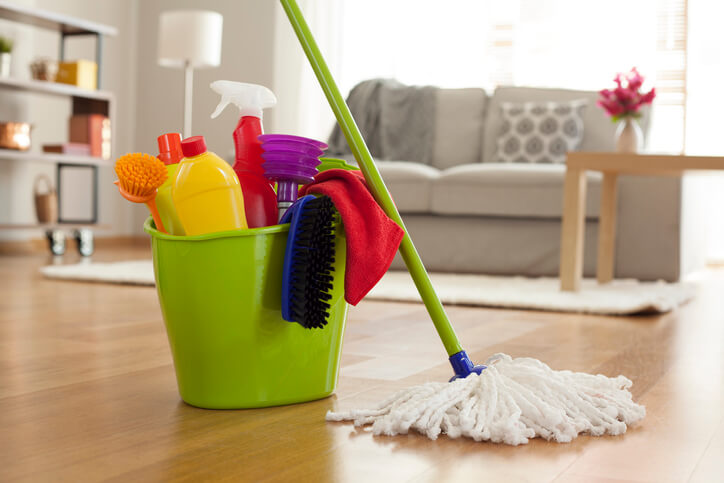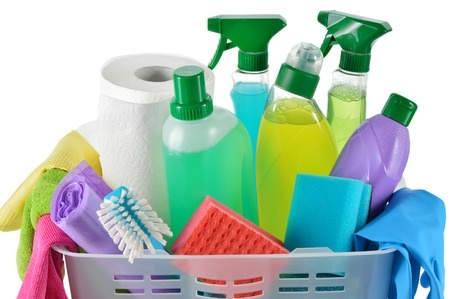- Clean Home
- Clean
- Best Household Germ Killers
The Best Household Germ Killers
How to choose the best household germ killers.
When your top priority is eliminating surface germs, opt for certified cleaning products. These products, labeled as 'disinfectant,' are guaranteed to meet stringent government specifications, ensuring your safety and peace of mind.
By checking for an EPA registration number on the label, you can be confident that the product has met the government's rigorous requirements for effectively killing household germs.
This empowers you to make informed choices about the active ingredients in these germ-killers, which may include:
- Sodium hypochlorite (chlorine bleach)
- Hydrogen peroxide
- Isopropyl (rubbing) alcohol
Bleach, hydrogen peroxide, and rubbing alcohol are good examples of generic products that are proven germ-killers on surfaces throughout your home, including tile, bathroom surfaces, walls, and floors.
You can also find many germ-killers (disinfectants) available under brand names.
Best Household Germ Killers
Probably the easy way to disinfect and trust the results is to find and use the best household germ killers available. Fortunately, you don't need to be a disinfectant detective to find effective germ-killers.
The EPA publishes lists of products it has tested and found to kill viruses, bacteria, and germs effectively.
- Search for "registered disinfectants" at epa.gov. For products to receive registration, a manufacturer must submit lab test results and descriptions of its manufacturing processes to the EPA. The EPA then reviews the data to deem it legit.
- You can also locate the EPA registration number on a product label, then enter the first two sets of numbers into a search tool on epa.gov to find out for which germ-killing claims the particular product has been approved.
- Another option to find EPA registered choices: read a product's label and look for words like kills germs or eliminates bacteria. Until a manufacturer proves its product kills germs through verified testing, it may not make such public health claims on its label.
Chlorine Bleach Is One Of The Best Household Germ Killers

Chlorine bleach - the kind that's not safe for colors - is a potent, economical disinfecting agent used for decades. Look for bleach containing 5.2 to 8.25 percent sodium hypochlorite.
But you don't need to - and shouldn't - bathe your surfaces in pure bleach to get beneficial effects. Because bleach is so strong, always dilute it with water.
Depending on the source, you will find different bleach-to-water ratios for use with regular bleach. The CDC recommends 1/3 cup of bleach per gallon of water or 4 teaspoons per quart.
Some product labels recommend a slightly stronger 1/2 cup of bleach per gallon or 2 tablespoons per quart.
The Cleaning Management Institute, a provider of training and certification for professional cleaning services, recommends a stronger 1:10 ratio (about one and one-half cups of bleach per quart of water); some medical disinfectants are the same solution.
You can use your judgment and comfort level to determine what solution is best for what you're cleaning.
Better Not with Bleach
Bleach is so powerful that there are certain times to pass it by.
- No mixing with ammonia. The combo forms a toxic gas.
- No touching your screen. Bleach will destroy the oleophobic (fingerprint-resistant) coating on your cell phone's screen.
- No mixing with metal. Bleach is corrosive, eating away at metal surfaces.
- No bare wood. Bleach can cause wood grains to swell.
- No upholstered furniture. Bleach can leave stains on upholstery.
To make an effective disinfecting solution for colorfast, non-porous surfaces, follow this CDC recipe:
- Mix 1/3 cup of bleach into a gallon of room-temperature or warm water or 4 teaspoons per one quart of water. Avoid mixing with hot water, as this can release additional chlorine gas into the air.
- Sponging the mixture on surfaces is the simplest way to disinfect them. You can also place the mixture in a spray bottle and spritz it liberally on surfaces. Ensure there are no metal parts on your bottle's trigger—bleach corrodes metal, which can introduce rust and contaminate your mixture.
Let the bleach mixture rest on the surface for at least 10 minutes before wiping it off with a soft cleaning cloth. If you don't give a disinfectant enough time to do its work, you're not disinfecting. You're wasting time and product.
Follow the instructions for application and these best practices for working with bleach:
- Ensure proper ventilation - simply cracking a window open can help.
- Wear gloves and safety glasses for added protection.
- Don't use a recycled bottle or old mixture. You'll have 24 hours to safely and effectively use a bleach and water solution.
- Bleach bottles should be kept away from heat and sunlight. When storing, find a cool, dry place for them.
- Toss bleach if it's been over a year since the product was made. How will you know? Again, the product label is the place to go for all the essential information you need to use a product safely. Look for an expiration date on the bleach bottle. You'll find it in the letters and numbers printed on the product label.
Be on the lookout for a sequence that looks like this: MR20106. This seemingly random set of letters and numbers means it was made in 2020 on the 106th day of the year. Don't worry about the letters as much as the numbers.
Places to disinfect with bleach: Countertops, sinks, faucets, tubs, toilets, doorknobs, drawer pulls, light switches, plastic toy boxes, and painted wood furniture, cabinets, and doors.
Best Household Germ Killers - Hydrogen Peroxide
According to the CDC, hydrogen peroxide is a safe and effective way to kill bacteria, viruses, and fungi on hard, nonporous surfaces.
Hydrogen peroxide produces free radicals that attack potential sources of infection and disease. The foaming bubbles you inevitably see when hydrogen peroxide comes into contact with a contaminated object?
That's the result of the free radicals going to work for you.
Brown Reasoning
Hydrogen peroxide comes in that classic brown bottle for a good reason. Exposure to light forces the active ingredients in hydrogen peroxide to decompose into water and oxygen, rendering the product utterly ineffective for the purpose for which we are looking.
The decomposition destroys the free radicals needed for an effective disinfectant. Always leave hydrogen peroxide in the original bottle rather than transferring it to a more attractive container. You can jazz up your cleaning routine by slipping the drab bottle into a beverage koozie.
Hydrogen peroxide comes in various strength levels. To disinfect at home, use the 3 percent hydrogen peroxide at your local grocery store or pharmacy.
It's inexpensive and easy to find. Skip the high-percentage hydrogen peroxide used for hair lightening or labeled as "food grade."
Hydrogen peroxide is a powerful bleaching agent at high concentrations, which is why it lightens hair and can damage household surfaces.
As with all the germ killers in your arsenal, this product's effectiveness depends on proper use during application.
When it comes time to disinfect a surface, always clean it first. You can use hydrogen peroxide right out of the bottle. Let it sit on the surface for 1 minute before wiping dry.
When it comes time to disinfect a surface, always clean it first. You can use hydrogen peroxide right out of the bottle. Let it sit on the surface for 1 minute before wiping dry.
To get the most benefit from your brown bottle, follow these guidelines:
- Store the bottle in a cool, dark place - not in your bathroom's medicine cabinet.
- Use hydrogen peroxide before the expiration date and within six months of purchase.
Do you still need to determine whether your bottle is effective? Here's an easy test: Pour a bit into a sink. If it bubbles (reacting with the metal), it's still good to go as a germ fighter.
When using hydrogen peroxide, test in an inconspicuous surface area to ensure it doesn't discolor or fade the surface.
Hydrogen peroxide is acidic and has bleaching properties, so it won't always be safe to use on every surface and object you want to disinfect.
If a surface is prone to bleaching or etching, hydrogen peroxide is not the product you wish to use. These surfaces include but are not limited to:
Marble, granite, and other natural stone (If you must use hydrogen peroxide, always dilute it with equal parts water.)
Certain metals (e.g., lead, brass, copper, and zinc)
PLACES TO DISINFECT WITH HYDROGEN PEROXIDE: Tubs, tile, and grout; toilets; small metal items, such as keys and tools; wooden cutting boards; refrigerator; sponges (both kitchen and bathing) and makeup blenders; thermometers; razors; and toothbrushes.
Best Household Germ Killers - Isopropyl (Rubbing) Alcohol
Isopropyl or rubbing alcohol kills most bacteria, fungi, and viruses. However, the norovirus can withstand alcohol.
However, rubbing alcohol evaporates very quickly. That quick evaporation makes it challenging to keep treated surfaces wet for the time necessary to disinfect.
Rubbing alcohol is best used on small and hard surfaces. For the best disinfecting results:
- Look for 70 percent alcohol concentration. Know that higher isn't always better. Isopropyl alcohol at 99 percent is pure isopropyl and evaporates before it can attack germs.
- Keep the surface visibly wet for a minimum of 30 seconds to ensure the alcohol destroys all germs.
Places to disinfect with alcohol: Computer keyboards, remote controls, smartphones, and anything else with a touchscreen. Just don't soak your electronics or get liquid near any openings.
When used properly, any of the above germ-killers can be counted on to get the deadly job done on your home's surfaces.
- Clean Home
- Clean
- Best Household Germ Killers









